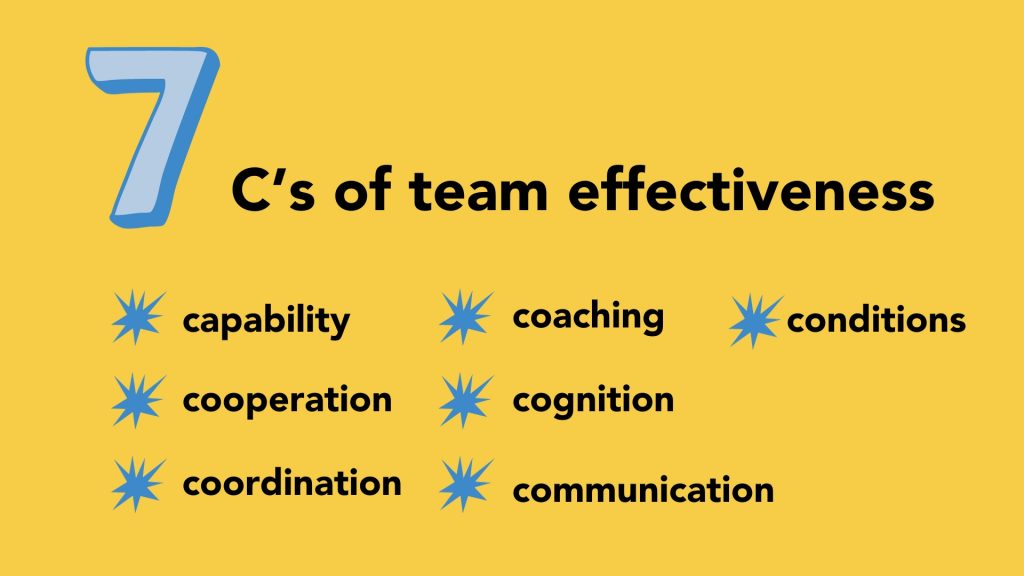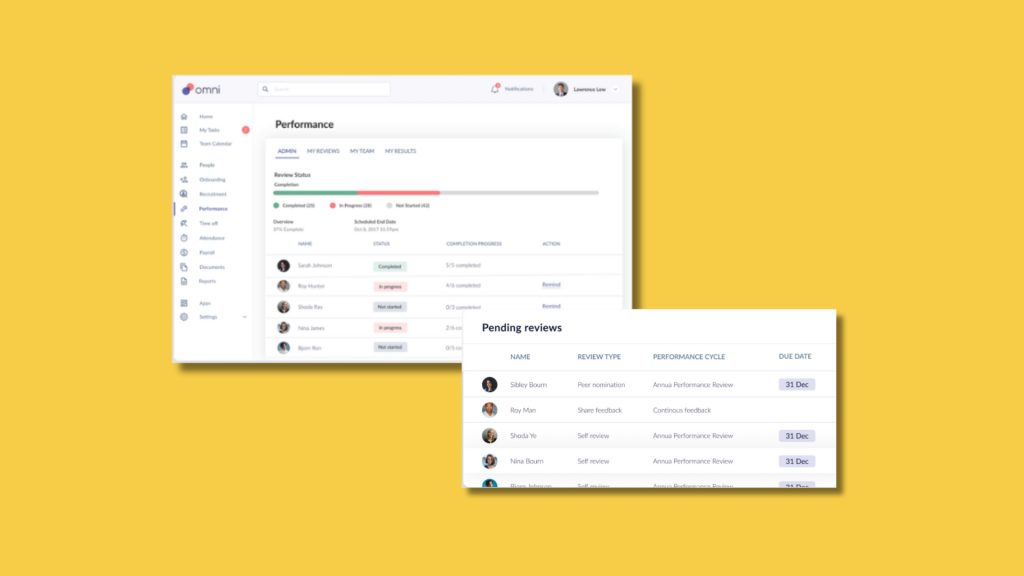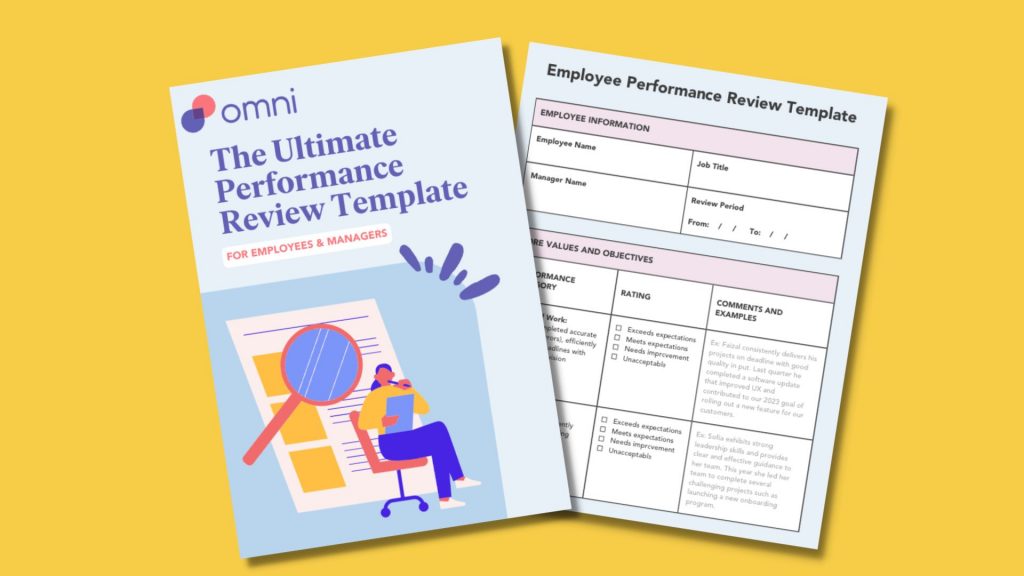While individual unicorns and leaders may get a lot of the attention on LinkedIn, it’s teams that form the backbone of productivity and innovation. But achieving optimal teamwork is more than a bit like solving a complex puzzle.
While many factors contribute to team effectiveness, 7 principles, often referred to as the 7 C’s of team effectiveness, have emerged as guiding stars for workplace collaboration. These 7 pillars (each beginning with the letter ‘C’) provide a comprehensive framework for creating cohesion, communication, and ultimately, success within a team.
The 7 C’s serve as more than just a catchy alliteration. They encapsulate the essential elements that propel a group of individuals towards a common goal. Here, we’ll not only explore each principle in-depth but also introduce you to other models and techniques that can illuminate the path to team effectiveness and employee engagement.
7 C’s of Team Effectiveness
The seven C’s of team effectiveness—Capability, Cooperation, Coordination, Communication, Cognition, Coaching, and Conditions—each represent a crucial aspect of what makes a team thrive and excel.

Capability
Think of capability as the diverse skill set that each team member brings to the table. It’s about recognizing and leveraging the unique strengths and talents within your team. A well-rounded team contributes to the overall performance of an organization, so a team with a variety of capabilities can tackle challenges innovatively and efficiently. Much of team effectiveness hinges on how capable each member is.
Cooperation
At the heart of team effectiveness is cooperation. It’s the engine that propels a team forward. Cooperation fosters a culture of collaboration and mutual support within your team, ensuring that everyone works together harmoniously. When team members cooperate effectively, they can navigate complex tasks more easily and achieve their goals with consistency and in shorter time frames.
Coordination
Coordination within a team is vital for success and team effectiveness. It involves managing tasks, timelines, and resources to ensure that everything runs smoothly. Effective coordination ensures that even when faced with challenging situations, your team remains on course.
Communication
Clear and open communication is the lifeblood of team effectiveness. It’s all about conveying thoughts, ideas, and information effectively. Effective communication not only prevents misunderstandings and conflicts but also promotes the free flow of information and fosters a sense of unity within the team.
Cognition
In the context of team effectiveness, think of cognition as collective thinking. It involves harnessing the combined intelligence and expertise of your team to solve complex problems. By encouraging a culture of shared learning and growth, teams can tackle intricate challenges with confidence.
Coaching
Effective leadership and coaching within a team are key to successful team effectiveness. It’s about nurturing talent, providing guidance, and setting the right course. Strong leadership can influence team dynamics, driving performance and success.
Conditions
The conditions under which a team operates play a significant role in team effectiveness. This includes aspects like the physical workspace, access to technology, and work-life balance. Creating the right conditions ensures that your team can perform at its best.
3 Performance Models to Improve Your Team Effectiveness
Teams are more than just collections of individuals—they are living entities with their own unique dynamics and developmental journeys. To navigate these waters and nurture an environment of peak performance, organizations and leaders often turn to established models.
In this section, we’ll delve into 3 influential performance models that have shaped the way we view and enhance team effectiveness. These models, namely the Tuckman Model, Belbin Team Roles Model, and Drexler/Sibbet Team Performance Model, offer valuable insights into the varied facets of team dynamics, from stages of development to individual roles and overall performance.
The Tuckman Model
Developed by psychologist Bruce Tuckman in 1965, this model has been a compass for countless teams negotiating the challenges of group development.
Tuckman’s research marked a significant milestone in our understanding of how teams evolve and mature over time, reaching optimal team effectiveness. He recognized that teams, like living organisms, undergo a series of stages, each with its own unique characteristics and challenges. These stages are:
Forming
In the forming stage, teams are just starting their journey. They might be brought together for a new project, or perhaps it’s the beginning of a new team within an organization. At this point, members are getting to know one another. They may be polite and cautious, as they’re uncertain about their roles and responsibilities. The focus is on understanding the team’s goals and tasks. Team members are generally excited, but they may also harbor some anxiety about what lies ahead.
Storming
The storming stage can be a bit turbulent (as the name implies). Now that team members have started to get comfortable with each other, they’re more likely to express their opinions. This can lead to conflicts and disagreements.
Storming is a critical phase on the path to team effectiveness because it’s during these clashes that important issues get addressed. It’s a time of adjustment and clarification, where individuals may challenge the team’s direction or leadership. Once these issues are resolved, it paves the way for greater clarity and understanding.
Norming
As the team works through the conflicts of the storming stage, they move into norming. In this phase, they’re beginning to find their groove. Team members resolve their differences and agree on their roles and responsibilities. They start developing a sense of unity and shared purpose. Collaboration becomes more fluid, and the atmosphere becomes more supportive. Trust begins to form, and members understand each other better.
Performing
The performing stage is often the sweet spot of teamwork. By this point, the team has ironed out most of the kinks. They are highly productive and effective. Everyone knows their role and is executing their tasks efficiently. The focus is on achieving the team’s goals, and team members are fully engaged in their work. Trust and collaboration are at their peak during this stage, resulting in outstanding performance.
Adjourning
Also known as the “mourning” stage in some models, adjourning occurs when the team disbands, typically after the completion of a project or a team’s life cycle. It’s a time for reflection on the team’s achievements and the journey they’ve been on together. Team members may say goodbye to colleagues who are moving on to other projects or roles, which can be a bittersweet moment.
Incorporating the Tuckman Model can help teams navigate the complexities of group dynamics and ultimately become more effective. It’s a valuable framework for understanding the stages of team development and how they impact a team’s performance.
The Belbin Team Roles Model
The Belbin Team Roles Model is another framework for enhancing team effectiveness. It outlines several distinct roles that individuals can play within a team, each contributing to the overall success of the group.
1. Resource Investigator
These team members are like explorers in uncharted territory. They have a natural flair for networking and connecting with people, both within and outside the team. Resource Investigators are adept at discovering external opportunities, making valuable contacts, and bringing fresh ideas back to the team. Their natural curiosity and enthusiasm can open doors to new possibilities. They thrive in dynamic environments where they can navigate through information to uncover hidden gems that can benefit the team.
2. Teamworker
Teamworkers are the glue that holds a team together. They excel at building and maintaining positive relationships among team members. These individuals are the peacemakers, often defusing conflicts and ensuring that everyone feels heard and valued. Teamworkers foster a cooperative and supportive atmosphere, making the team a comfortable space for collaboration. They have a remarkable ability to boost team morale and enhance group cohesion, paving the way for team effectiveness.
3. Coordinator
Coordinators are the organizers of the team. They have a knack for setting clear objectives and defining roles and responsibilities. These individuals excel at delegation and resource allocation, ensuring that tasks are distributed effectively. Coordinators are skilled at keeping the team focused on its goals and aligned with the broader organizational objectives. Their structured approach and strategic thinking help the team work efficiently and achieve its targets.
4. Plant
Plants are the creative thinkers of the team. They are known for their innovative ideas and solutions. These individuals often see things from a unique perspective and bring a fresh approach to problem-solving. Plants can introduce unconventional and imaginative concepts that challenge the status quo and inspire creativity within the team. Their ability to think outside the box can lead to breakthroughs and innovative solutions.
5. Monitor Evaluator
Monitor Evaluators are the critical thinkers. They have a discerning eye for detail and objectivity. These individuals can evaluate ideas and plans with a high degree of impartiality, ensuring that the team’s decisions are well-informed. They prevent the team from making hasty judgments and encourage a thoughtful, analytical approach. Monitor Evaluators are instrumental in maintaining the team’s focus on quality and rigor.
6. Specialist
Specialists are the experts in their field. They possess in-depth knowledge and expertise that are indispensable to the team’s success. These individuals are often sought after for their specialized skills and experience. Specialists provide valuable insights and guidance in specific areas, making them the go-to resource when the team encounters challenges related to their expertise.
7. Shaper
Shapers are the driving force behind the team’s progress. They thrive on challenges and have a strong desire to achieve. Shapers are known for their determination and assertiveness. They push the team to perform at its best, often by setting ambitious goals and taking bold actions. Their competitive spirit and willingness to confront obstacles head-on can energize the team and drive it toward success.
8. Implementer
Implementers are the individuals who turn plans into action. They are reliable, efficient, and focused on execution. Implementers ensure that tasks are completed according to the team’s objectives and timelines. These team members have a talent for organizing resources and managing projects effectively. Their disciplined approach ensures that the team’s strategies are put into practice and are key drivers of team effectiveness.
9. Completer Finisher
Completer Finishers have a keen eye for detail and a commitment to excellence. They are perfectionists who meticulously review work to ensure that it meets high standards. These individuals excel at catching errors and ensuring that nothing is overlooked. Completer Finishers have a strong sense of responsibility and take pride in delivering work that is accurate and error-free.
Each Belbin Team Role brings a unique set of strengths and qualities to the team. The key lies in understanding how each role contributes to the team’s dynamics and team effectiveness, ensuring that they work harmoniously together.
The Drexler/Sibbet Team Performance Model
Developed by David Sibbet and Arthur M. J. Drexler, the Drexler/Sibbet Team Performance Model has been a beacon for organizations seeking to enhance team effectiveness and efficiency since its inception in the 1980s.This model offers a comprehensive framework to help teams not only create themselves but also sustain their high performance.
Create the Team
Building a successful team is akin to constructing a complex puzzle; every piece must fit seamlessly for the picture to emerge clearly. The Drexler/Sibbet Team Performance Model offers a structured approach to this endeavor.
Why: Before assembling your team, it’s essential to understand the purpose behind it. Define the specific goals and objectives your team aims to achieve. This clarity of purpose will guide every subsequent step.
Who: Identifying the right individuals is key. Assess the skill sets, personalities, and experiences of potential team members. Ensure a diverse mix that complements one another.
What: Determine the tasks and responsibilities of each team member. Who will be in charge of what, and how do these roles align with the team’s purpose?
How: Lastly, establish the processes and workflows that will govern your team’s operations. Effective communication channels, collaboration tools, and decision-making frameworks are all part of the ‘how.’
Sustain Performance
Once your team is in place, it’s vital to sustain and enhance its performance continually. The Drexler/Sibbet Model provides a roadmap for this ongoing journey.
Who, What, When, Where: Regularly assess who is on the team, what they are doing, when they are doing it, and where these activities take place. This ongoing evaluation ensures alignment with the team’s purpose and tasks.
Why: Constantly revisit the ‘why’ of your team’s existence. As your organization evolves, so too may its objectives. Adapting to changing needs ensures your team remains relevant.
Wow: Encourage innovation and excellence within your team. Foster a culture of continuous improvement, inspiring your team members to go above and beyond in their efforts.
This framework can help you be better equipped to create and sustain a high-performing team that can navigate even the most challenging business environments.
Boost Your Team Effectiveness with Automated Performance Management

Implementing performance models into your performance management strategy is an impactful effort towards team effectiveness. Yet performance management requires additional systems and strategies to build enduring change within your organization.
Leveraging automation allows you to streamline your processes while gaining actionable insights for continuous improvement and team effectiveness.Through leveraging the power of automation, Omni allows HR teams and managers access to performance data that drives targeted approaches to swiftly addressing performance gaps and fostering growth within your organization. Our comprehensive and highly customizable performance review capabilities arm your team with the tools necessary to maintain regular performance analysis, and keep employees informed and motivated year round.
Book a demo with our team to learn more about how Omni’s can improve your performance management and help address performance gaps to foster a culture of continuous growth.

For more support in your performance management journey, download our free Ultimate Performance Review Template and get started on improving your team performance today.


